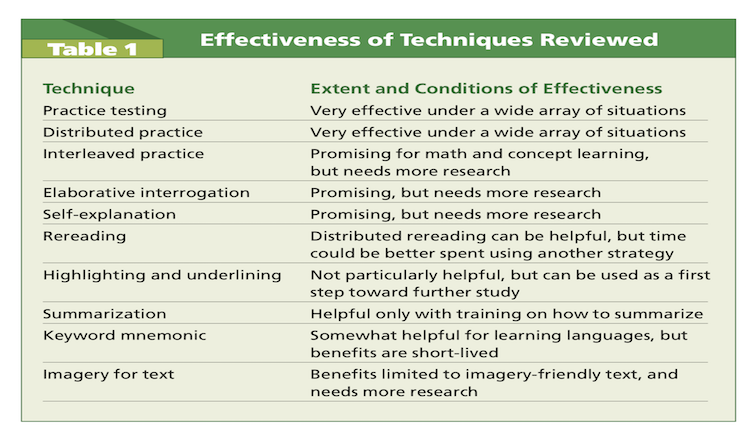What strategies work best to boost learning?
This is the million dollar question that teachers and students need to answer to so they can be successful at school/university/ in life.
Here at HRC we believe that the knowledge required to do well in history – the substantive ‘stuff” and disciplinary ‘conceptual and analytical’ – are best first acquired through the English tradition of teaching using enquiry questions. This requires the teacher to plan for the development of the substantive and the disciplinary, through the focus and wording of the enquiry question and the learning sequence that follows.
So much has been written about enquiry questions that we won’t dwell on it here. However, our own classroom research tells us that this is the way to go to learn new historical knowledge.
Unfortunately, English teachers and students work in a world where there is ever increasing pressure to recall large amounts of information over two or three years and show that they can apply it. A tiny amount of this knowledge will then appear in an exam paper and be tested in a public examination.
Whether this system is right or wrong is open to debate. The fact remains that to be judged as a success by her or his school leaders, the English history teacher has to get students to think historically and recall loads of stuff so students perform well in external examinations.
So what appear to be the best techniques to get students to acquire then retain learning and content over longer periods of time?
American professor, John Dunlosky argues that teachers should know what the best strategies are and they should then share these strategies with their students, so they know what is going to work for them when it comes to revision.
How often near to internal tests and exams do teachers set this one-word homework: REVISE? For success, students to need to self regulate their learning (revise regularly). But do your students actually know how to revise?
If kids think revision means to re-read their work over and over then this is what they will do. Without knowing that this is not a good technique these hard-working youngsters will have wasted much time and effort and learnt relatively little.
So, when it comes to retaining learning/content over time, what techniques and strategies are good, bad and the ugly?
Dunlosky and his collaborators, including Daniel T Willingham, reviewed the effectiveness of 10 strategies that could be used for revision or self-regulation then worked out which worked best.
The 10
- Practice testing: self-testing or taking practice tests on to-be-learned material.
- Distributed practice: implementing a schedule of practice that spreads out study activities over time.
- Interleaved practice: implementing a schedule of practice that mixes different kinds of problems, or a schedule of study that mixes different kinds of material, within a single study session.
- elaborative interrogation: generating an explanation for why an explicitly stated fact or concept is true.
- self-explanation: explaining how new information is related to known information, or explaining steps taken during problem-solving.
- rereading: restudying text material again after an initial reading.
- highlighting and underlining: marking potentially important portions of to-be-learned materials while reading.
- summarization: writing summaries (of various lengths) of to-be-learned texts.
- Keyword mnemonic: using keywords and mental imagery to associate verbal materials.
- Imagery for text: attempting to form mental images of text materials while reading or listening.
They noted that different strategies promoted different types of learning. Some focused on remembering core facts, others on comprehension and some on recall and comprehension.
The Best Two
The two most effective techniques according to the research were practice testing and distributed practice.
Practice testing
 Practice testing is just about recalling information from one’s memory rather than reading the information over and over. Short multiple-choice, retrieval of content, true /false statement kind of tests work well. Recalling directly from memory is apparently best.
Practice testing is just about recalling information from one’s memory rather than reading the information over and over. Short multiple-choice, retrieval of content, true /false statement kind of tests work well. Recalling directly from memory is apparently best.
Not only does this technique strengthen long-term memory, but it also shows your students (or the teacher) where the gaps in their knowledge are, so they can pinpoint future learning.
Distributed practice
Distributed practice involves distributing revision or learning over time rather than completing the learning once. So, the night before revision is cramming or massed practice where students look at the same information at once and try and learn it. Distributed practice involves re-visiting the information at different times over a period so it is distributed times over. This supports Ebbinghaus’s forgetting curve.
According to Dunlosky:
‘students will retain knowledge and skills for a longer period of time when they distribute their practice than when they mass it, even if they use the same amount of time massing and distributing their practice.’
These two strategies are the inspiration behind www.historyhomework.com
Your students log in and complete the test that you have set them on any particular area of the specification. They use their recall skills to strengthen their long-term memory to complete the tasks and you get gap analysis data about how much they know. You can then re-set them to test at any point across the course to build their knowledge and distribute the practice.
HistoryHomework.com – marks your homework and revision tasks for you!
The Good(ish) but is it good for the history teacher and student?
Interleaving
There has been much talk about interleaving. It is the same as distributed practice but also involves mixing up the order of content too so students solve the same type of problem at different points over time. This has become popular in some schools and might work in some subjects. However, I worry about the interleaving of content in history GCSE course. I wouldn’t recommend starting with the Treaty of Versailles for a Germany study, then immediately switching to Medival Punishment, then Religion under Elizabeth and then return to 1923 Germany. It seems too confusing to me and kids may well be lost in time.
Instead, I would recommend you interleave the conceptual across time – eg causation questions, then interpretations etc.
The OK
Summarisation
Perhaps this technique shouldn’t be in the bad and ugly category because it works pretty well but according to Dunlosky’s study needs extensive teacher training to make it work for students.
Keyword mnemonics and imagery for text
I for one have often asked students to recall key information as a mnemonic. So Eileen Enjoys Nightly Passions is a good way to remember key events of Hitler’ establishment of his dictatorship: Election, Enabling Act, Night of the Long Knives, Hitler becomes President.
Such mnemonics have worked for me and some students in this limited context before.
Imagery for text involves students trying to picture mental images of the content so they can remember it. This can be effective but hard for students to imagine complex concepts and ideas or historical situations.
The bad and the ugly?
Re-reading and highlighting
As stated above, most students think revision equals re-reading notes, sometimes highlighting ‘important’ bits. Some teachers worry about student class books not having enough ‘notes’ in them for revision. I often hear teachers reluctant to take an enquiry based approach at GCSE because the students ‘won’t have the notes they need to revise from.’
However, re-reading notes according to this study is not effective unless it is then coupled with practice testing or distributed practice. So perhaps teachers should be braver with their initial ‘teaching’. Perfect ‘notes’ are not going to help unless you train your kids to revise properly.
It is worth reminding ourselves that research like this can help us. However, I would stress that you test out the theories suggested against your own experience as a teacher researcher. You need to find out what works for you and your students and then share the research and techinques with them.



